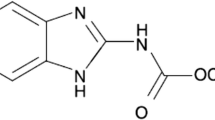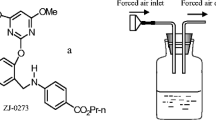Abstract
The different techniques like spectroscopy and fluorescence quenching were used to study the interactive effect of carbendazim (CARB) and catalase (CAT) at the molecular level. The results showed that conditions were beneficial to the quenching mechanism at 25.0 °C, pH 7.0, while the binding constant k was 1.92 × 105 L mol−1 and the number of binding site was 1.0385. The thermodynamic parameters indicated that CARB could interact spontaneously with CAT to form a complex mainly by van der Waals’ interactions and hydrogen bonds. The interaction mechanism between CARB and CAT was that the effects of CARB on CAT in soil were activated and then restore stability. However, the effects of CARB on simple CAT were activated and then inhibited.







Similar content being viewed by others
References
Achiorno CL, de Villalobos C, Ferrari L (2018) Susceptibility of Chordodes nobilii (Gordiida, Nematomorpha) to three pesticides: influence of the water used for dilution on endpoints in an ecotoxicity bioassay. Environ Pollut 242:1427–1435
Akbarsha MA, Kadalmani B, Girija R, Faridha A, Hamid KS (2001) Spermatotoxic effect of carbendazim. Indian J Exp Biol 39:921–924
Chi Z, Zhao J, Li W, Araghi A, Tan S (2017) In vitro assessment of phthalate acid esters-trypsin complex formation. Chemosphere 185:29–35
Cui FL, Zhang QZ, Yan YH et al (2008) Study of characterization and application on the binding between 5-oclouridine with HSA by spectroscopic and modeling. Carbohydr Polym 73(3):464–472
Elgueta S, Moyano S, Sepúlveda P, Quiroz C, Correa A (2017) Pesticide residues in leafy vegetables and human health risk assessment in North Central agricultural areas of Chile. Food Addit Contam: Part B 10(2):105–112
Fang H, Wang YQ, Gao CM et al (2010) Isolation and characterization of pseudomonas sp. CBW capable of degrading carbendazim. Biodegradation 21(6):939–946
Fatemi FR, Fernandez IJ, Simon KS, Dail DB (2016) Nitrogen and phosphorus regulation of soil enzyme activities in acid forest soils. Soil Biol Biochem 98:171–179
Ferreira AL, Loureiro S, Soares AM (2008) Toxicity prediction of binary combinations of cadmium, carbendazim and low dissolved oxygen on daphnia magna. Aquat Toxicol 89(1):28–39
Gholami S, Bordbar AK (2014) Exploring binding properties of naringenin with β-lacto globulin: a fluorescence, molecular docking and molecular dynamics simulation study. Biophys Chem 187(/188):33–42
Ghorab MM, Alsaid MS, Al-Dosari MS, El-Gazzar MG, Parvez MK (2016) Design, synthesis and anticancer evaluation of novel quinazoline-sulfonamide hybrids. Molecules 21:189–200
Goodson WH, Lowe L, Carpenter DO et al (2015) Assessing the carcinogenic potential of low-dose exposures to chemical mixtures in the environment: the challenge ahead. Carcinogenesis 36(1):254–296
Gu W, Yan Y, Pei X, Zhang C, Ding C, Xian Y (2017) Fluorescent black phosphorus quantum dots as label-free sensing probes for evaluation of acetylcholinesterase activity. Sensors Actuators B Chem 250:601–607
Huan Z, Luo J, Xu Z, Xie D (2016) Acute toxicity and genotoxicity of carbendazim, main impurities and metabolite to earthworms (eisenia foetida). Bull Environ Contam Toxicol 96(1):62–69
Paramaguru G, Kathiravan A, Selvaraj S, Venuvanalingam P, Renganathan R (2010) Interaction of anthraquinone dyes with lysozyme: evidences from spectroscopic and docking studies. J Hazard Mater 175(1):985–991
Shen WD, Wu YG, Huang BP et al (2011) Heavy metal contamination and enzyme activity of topsoil in abandoned coal mining area in Xingren county of Guizhou Province. Guizhou Agric Sci 39(3):111–115 (in Chinese)
Shu YY, Huang JS, Zhao GJ et al (2016) Effects of afforestation with different tree species on soil enzyme activities and nutrient content in eastern Qinghai-Tibetan Plateau, China. Acta Ecol Sin 36(2):394–402 (in Chinese)
Wang GL, Wang LL, Shen ZJ et al (2004) Study on relation of heavy metal pollution in soils of rice lands near smeltery and enzyme activities. J Anhui Normal Univ (Nat Sci) 27(3):310–313 (in Chinese)
Wang JY, Sun HZ, Bu YQ et al (2017) Effect of chlorpyrifos on enzyme activities and microbial activity in Zijin Mountain Forest Soil. Asian J Ecotoxicol 12(4):210–218 (in Chinese)
Wang X, Shen G, Hu S, et al. (2016) Effects of single and joint pollution of chromium (VI) and phenanthrene on microbiological enzyme activities in soil. Journal of Agro-Environment Science 35(7):1300–1307 (in Chinese)
Xia D, Dong C, Xinglei W et al (2018) Effects of heavy metal accumulation on soil enzyme activities in Yili coal mines. Environ Chem 37(7):1554–1564 (in Chinese)
Xiaomin X, Jiyun C, Bangrui L, Lijuan T (2018) Carbendazim residues in vegetables in China between 2014 and 2016 and a chronic CARB exposure risk assessment. Food Control 91:20–25
Zhu M, Wang L, Zhang H, Fan S, Wang Z, Li QX, Wang Y, Liu S (2018) Interactions between tetrahydroisoindoline-1,3-dione derivatives and human serum albumin via multiple spectroscopy techniques. Environ Sci Pollut Res 25:17735–17748
Funding
This work was financially supported by National Natural Scientific Fund (No. 21665027), YMU-DEAKIN International Associated Laboratory on Functional Materials, Key Laboratory of Resource Clean Conversion in Ethnic Region, Education Department of Yunnan Province (117-02001001002107), and Natural Science Foundation of Yunnan Province (2016FB014).
Author information
Authors and Affiliations
Corresponding author
Additional information
Responsible editor: Robert Duran
Publisher’s note
Springer Nature remains neutral with regard to jurisdictional claims in published maps and institutional affiliations.
Rights and permissions
About this article
Cite this article
Lu, G., Tan, W., Li, G. et al. Effects of carbendazim on catalase activity and related mechanism. Environ Sci Pollut Res 27, 24686–24691 (2020). https://doi.org/10.1007/s11356-019-06125-7
Received:
Accepted:
Published:
Issue Date:
DOI: https://doi.org/10.1007/s11356-019-06125-7




